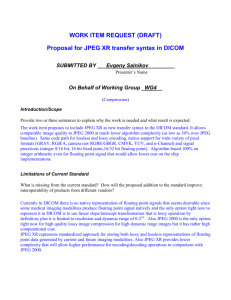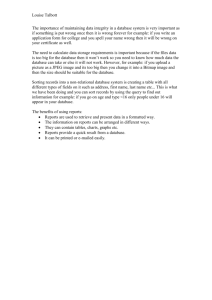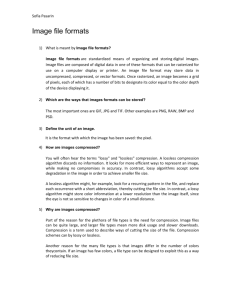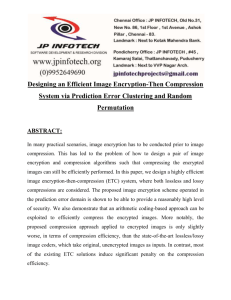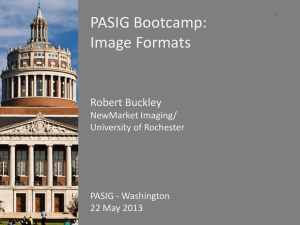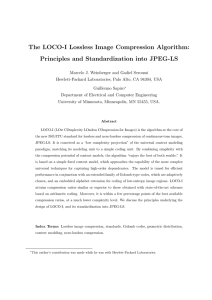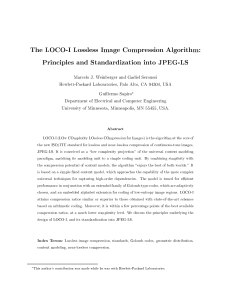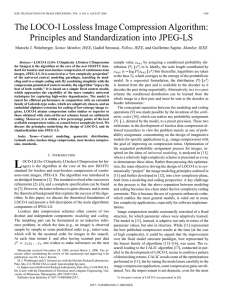Rashmi Proposal
advertisement
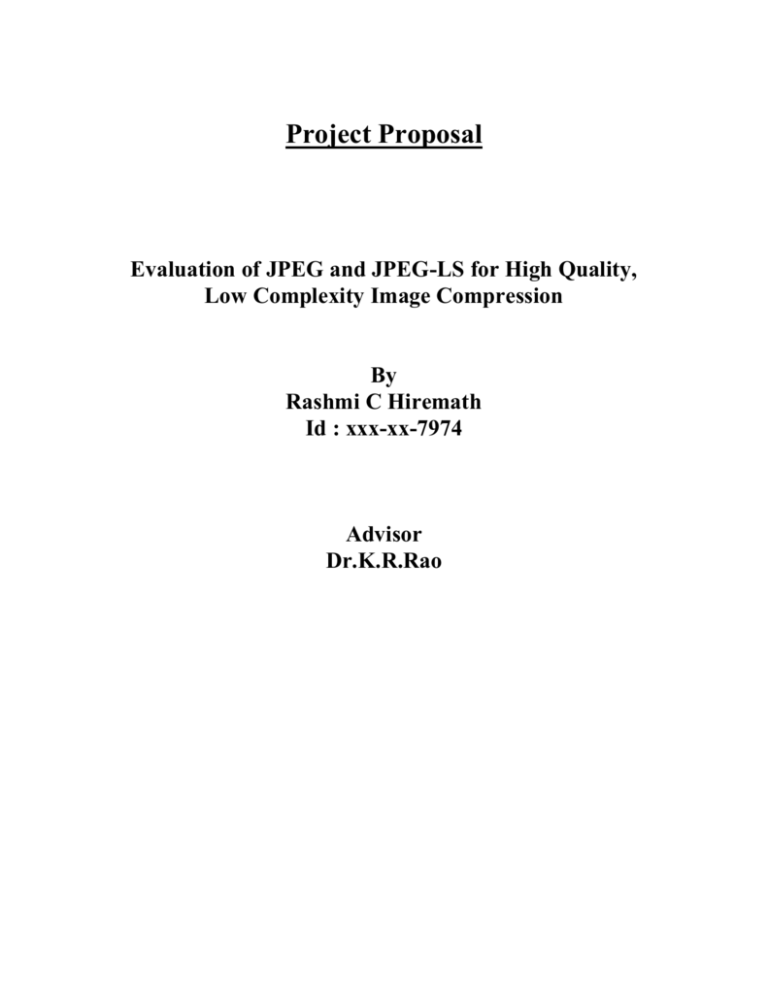
Project Proposal Evaluation of JPEG and JPEG-LS for High Quality, Low Complexity Image Compression By Rashmi C Hiremath Id : xxx-xx-7974 Advisor Dr.K.R.Rao Evaluation of JPEG and JPEG-LS for High Quality, Low Complexity Image Compression Introduction As a part of this project, still image compression standards JPEG (Joint Photographic Expert Group) and JPEG-LS (Lossless and near lossless ) will be studied and implemented. Their implementation on a programmable digital signal processor (DSP) will also be considered. Depending on the actual scope of the project, an evaluation of current DSP architectures, and scope for hardware-software partitioning may also be examined. In section-1 of this proposal, a brief description of JPEG and JPEG-LS algorithms is given. Section-2 offers justification for selecting these two standards for study and implementation. Section-3 lists some applications of these standards. Section-4 lists the various steps involved in executing this proposal. 1.Brief description of JPEG and JPEG-LS JPEG JPEG[7] is very well known ISO/ITU-T standard created in late 1980's. There are several modes defined for JPEG including baseline, progressive and hierarchical .The baseline mode, which supports lossy compression alone, is most popular. In the baseline mode, the image is divided into 8x8 blocks of pixels. The discrete cosine transform (DCT) and Huffman entropy coding are the key functions employed in this standard. Among other applications, it is the key enabler for the digital still camera market[1]. JPEG-LS JPEG-LS [1] is a recent ISO/ITU-T standard for lossless coding of still images. In addition, it also provides support for "near-lossless" compression. The main goal of JPEG-LS has been to deliver a low complexity solution for lossless image coding with the best possible compression efficiency. It is based on the LOCO-I (low complexity lossless compression for images) algorithm[2], using adaptive prediction, context modeling and Golomb coding. It supports near lossless compression by allowing a fixed maximum sample error. 2. WHY JPEG and JPEG-LS? Apart from JPEG and JPEG-LS, there are many other options for still image coding including the wavelet based JPEG2000[3], PNG[4] [1](portable network graphics format), or even the latest video codec specification, MPEG-4 (Moving Picture Expert Group) – VTC (Visual Texture Coding ) [5]etc. The following table summarizes the results of comparison of different algorithms from a functionality point of view. Table 2.1 Functionality Matrix [1] A "+" indicates that it is supported, the more "+”, the more efficiently or better it is supported. A "-" indicates it is not supported. JPEG-LS offers lossless and near lossless compression with good compression ratio with the least complexity and at much lesser cost than these other alternatives. JPEG gives good compression results for lossy compression with the least complexity. JPEG2000[3] provides best results with a rich set of features for lossless compression along with a decent lossless performance. However, its complexity is relatively high, compared with JPEG and JPEG-LS. Complexity of the encoder in PNG is much higher than that of JPEG-LS. MPEG-4 VTC offers the ability to code arbitrarily shaped objects and many new features, but its complexity is quite high. Specifically, for application that do not require any JPEG-2000 functionalities such as progressive bit-streams, error resilience, region of interest coding (ROI) etc, the combination of JPEG-LS and JPEG stands out as a viable alternative for many embedded and cost-sensitive applications. 3. Applications of JPEG and JPEG-LS JPEG baseline system (lossy), and JPEG-LS (lossless and near lossless) standards are used in many applications. A few of these are 1. Digital Video (camcorders) 2. Security video cameras 3. Digital still cameras 4. Medical image compression 5. High speed video capture (with frame-selectable editing) 6. JPEG files over internet. 4. Project Execution There are 4 steps involved in executing this project. Step-1: Software implementation of JPEG [9]and JPEG-LS[10] encoder and decoder (in C). Understanding the processing complexity of both the standards. Comparing JPEG with JPEG-LS for near lossless compression (around 2-4 bits/pixel, original image at 8bpp). This will make use of a standard test image suite[6]. Step-2: Performing a analysis of processing and I/O bandwidth requirements for a few potential applications. Evaluation of different DSP architectures for implementing these applications in terms of execution time, and data transfer capabilities. Step-3: Porting the JPEG and JPEG-LS code (from step-1) to a selected DSP. This will make use of the DSP C compiler, along with assembly level optimization of critical functions. Apart from processing speed, other critical issues such as memory requirements will also be considered. Step-4: If it is determined that a more cost-efficient solution that leverages hardware support for any function is likely, we will examine the related aspects, depending on the time available. References: 1. Diego Santa cruz, and Touradj Ebrahimi “An Analytical study of JPEG 2000 Functionalities” IEEE transactions on Image processing, vol.2, pp.49-52,Sep 2000. 2. M. Weinberger, G. Seroussi, G. Sapiro, "The LOCO-I Lossless Image Compression Algorithm: Principles and Standardization into JPEG-LS", Hewlett-Packard Laboratories Technical Report No. HPL-98-193R1, November 1998, revised October 1999. IEEE Trans. Image Processing, Vol. 9, pp.13091324,Aug 2000. http://www.hpl.hp.com/loco/indexold.htm 3. D.S Taubman and W.M Marcellin , “JPEG2000: Image Compression Fundamentals, Standards and Practices”, Norwell, MA;Kluwer 2002. 4. J. Maiano, “Compressed Image File Formats; JPEG, PNG, GIF, XBM, BMP,” (Software CDROM) ACM Press. Addison Wesley,1999. 5. I.E.G.Richardson, “H.264 and MPEG-4 Video Compression”, Hoboken,NJ;wiley,2003. 6. Image database : http://www.imageprocessingbook.com/DIP2E/image_databases/image_databases .htm 7. W.B.Pennebaker and J.L.Mitchell, “JPEG still image data compression standard”,Van Nostrand Reinhold,1993. 8. K. Sayood, “Introduction to data compression,” San Francisco, CA: Morgan 2nd edition ,2000. . Software : 9.. JPEG : www.ijg.com 10. JPEG-LS : http://www.hpl.hp.com/loco/software.htm Kaufman, 1995,

